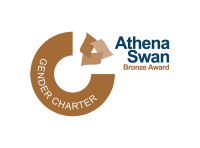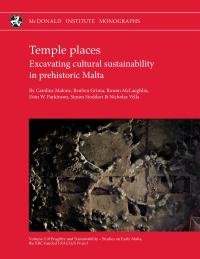
Our full catalogue is presented here by publication date. Our publications are distributed by Pen & Sword Books/Casemate Academic. Direct links to Pen & Sword Books are included in the catalogue where the book is still in print. We also sell some of our publications as e-books.
Volumes published under the McDonald Conversations Series (online open access only) have links to the University of Cambridge repository Apollo, where they may be freely accessed.
A small number of back catalogue volumes, where marked, are also available for sale as e-books.
Publications
Temple places | Social inequality before farming? | The pasts and presence of art in South Africa | Temple landscapes | The Isola Sacra | Pattern and process | Hinterlands and Inlands | Fuel and Fire in the Ancient Roman World | Towards a Broader View of Hunter-Gatherer Sharing | Medieval to Modern Suburban Culture | The Evolution of Fragility | Far from the Hearth | Kavos and the Archaeology of Ritual | An Age of Experiment | Age of 3D digital reproductions | Riversides | Delicate Urbanism in context | Boeotia Project, Volume II | The archaeology of the Niah Caves | The pottery from Dhaskalio | Twice-crossed river | The provincial archaeology of the Assyrian Empire | Kavos and the special deposits
2020
Temple places: Excavating cultural sustainability in prehistoric Malta
edited by Caroline Malone, Reuben Grima, Rowan McLaughlin, Eoin W. Parkinson, Simon Stoddart and Nicholas Vella
Hardback | £65.00 / US $86.00 | ISBN 978-1-913344-02-3 | xl + 512 pp. | 475 figs | 230 tables | 2020 | Buy now
eBook | ISBN 978-1-913344-03-0 | xl + 512 pp. | 475 figs | 230 tables | 2020 | Download now for free

The ERC-funded FRAGSUS Project (Fragility and sustainability in small island environments: adaptation, culture change and collapse in prehistory, 2013–18) led by Caroline Malone (Queen’s University Belfast) has focused on the unique Temple Culture of Neolithic Malta, and its antecedents and successors through investigation of archaeological sites and monuments. This, the second volume of three, presents the results of excavations at four temple sites and two settlements, together with analysis of chronology, economy and material culture.
The project focused on the integration of three key strands of Malta's early human history (environmental change, human settlement and population) set against a series of questions that interrogated how human activity impacted on the changing natural environment and resources, which in turn impacted on the Neolithic populations. The evidence from early sites together with the human story preserved in burial remains reveals a dynamic and creative response over millennia. The scenario that emerges implies settlement from at least the mid-sixth millennium bc, with extended breaks in occupation, depopulation and environmental stress coupled with episodes of recolonization in response to changing economic, social and environmental opportunities.
Excavation at the temple site of Santa Verna (Gozo) revealed an occupation earlier than any previously dated site on the islands, whilst geophysical and geoarchaeological study at the nearby temple of Ġgantija revealed a close relationship with a spring, Neolithic soil management, and evidence for domestic and economic activities within the temple area. A targeted excavation at the temple of Skorba (Malta) revisited the chronological questions that were first revealed at the site over 50 years ago, with additional OSL and AMS sampling. The temple site of Kordin III (Malta) was explored to identify the major phases of occupation and to establish the chronology, a century after excavations first revealed the site. Settlement archaeology has long been problematic in Malta, overshadowed by the megalithic temples, but new work at the site of Taċ-Ċawla (Gozo) has gathered significant economic and structural evidence revealing how subsistence strategies supported agricultural communities in early Malta. A study of the second millennium bc Bronze Age site of In-Nuffara (Gozo) likewise has yielded significant economic and chronological information that charts the declining and changing environment of Malta in late prehistory.
Caroline Malone is a Professor in the School of Natural and Built Environment, Queen’s University Belfast.
Reuben Grima is a Senior Lecturer in the Department of Conservation and Built Heritage, University of Malta.
Rowan McLaughlin is Senior Researcher in the Department of Scientific Research at the British Museum, and previously Research Fellow for the FRAGSUS Project; he is honorary research scholar at Queen’s University Belfast.
Eóin W. Parkinson completed his PhD at Cambridge University and is currently Leverhulme Research Fellow at the University of Malta.
Simon Stoddart is Reader in Prehistory in the Department of Archaeology, University of Cambridge.
Nicholas C. Vella is Associate Professor of Mediterranean Archaeology in the Department of Classics and Archaeology, University of Malta.
Social inequality before farming? Multidisciplinary approaches to the study of social organization in prehistoric and ethnographic hunter-gatherer-fisher societies
edited by Luc Moreau
eBook | ISBN 978-1-913344-00-9 | xii + 320 pp. | 57 figs | 25 tables | 2020 | Download now for free
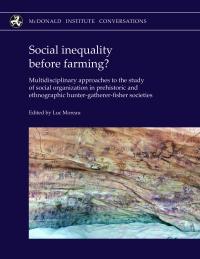
Archaeological investigations over the past 50 years have challenged the importance of domestication and food production in the emergence of institutionalized social inequality. Social inequality in the prehistoric human past developed through multiple historical processes that operate on a number of different scales of variability (e.g. social, economic, demographic, and environmental). However, in the theoretical and linguistic landscape of social inequality, there is no clear definition of what social inequality is. The lifeways of hunter-gathererfisher societies open a crucial intellectual space and challenge to find meaningful ways of using archaeological and ethnographic data to understand what social inequality exactly is with regard to variously negotiated or enforced cultural norms or ethoses of individual autonomy. This interdisciplinary edited volume gathers together researchers working in the fields of prehistoric archaeology and cultural and evolutionary anthropology. Spanning terminal Pleistocene to Holocene archaeological and ethnographic contexts from across the globe, the nineteen chapters in this volume cover a variety of topics organized around three major themes, which structure the book: 1) social inequality and egalitarianism in extant hunter-gatherer societies; 2) social inequality in Upper Palaeolithic Europe (c. 45,000–11,500 years ago); 3) social inequality in prehistoric Holocene hunter-gatherer-fisher societies globally. Most chapters in this volume provide empirical content with considerations of subsistence ecology, demography, mobility, social networks, technology, children’s enculturation, ritual practice, rock art, dogs, warfare, lethal weaponry, and mortuary behaviour. In addition to providing new data from multiple contexts through space and time, and exploring social diversity and evolution from novel perspectives, the collection of essays in this volume will have a considerable impact on how archaeologists define and theorize pathways both towards and away from inequality within diverse social contexts.
Luc Moreau is a research affiliate and immediate-past Marie Skłodowska-Curie Fellow of the McDonald Institute for Archaeological Research at the University of Cambridge, United Kingdom. His research focuses on the study of Upper Palaeolithic behavioural variability and adaptations towards the Last Glacial Maximum. His publications deal with various aspects including stone tool technology and human mobility based on sites from Northwestern, Central and Eastern Europe. He is an affiliate member of the French Unité Mixte de Recherches (UMR) 7041 ‘Archéologies et Sciences de l’Antiquité’ based in Paris/Nanterre, and Secretary of the International Society for Hunter Gatherer Research (ISHGR).
The pasts and presence of art in South Africa Technologies, ontologies and agents
edited by Chris Wingfield, John Giblin and Rachel King
eBook | ISBN 978-1-913344-01-6 | xiii + 206 pp. | 95 figs | 0 tables | 2020 | Download now for free
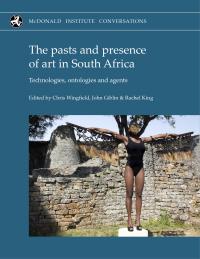
In 2015, #RhodesMustFall generated the largest student protests in South Africa since the end of apartheid, subsequently inspiring protests and acts of decolonial iconoclasm across the globe. The performances that emerged in, through and around #RhodesMustFall make it clear how analytically fruitful Alfred Gell’s notion that art is ‘a system of social action, intended to change the world rather than encode symbolic propositions about it’ can be, even when attempting to account for South Africa’s very recent history.
What light can this approach shed on the region’s far longer history of artistic practices? Can we use any resulting insights to explore art’s role in the very long history of human life in the land now called South Africa? Can we find a common way of talking about ‘art’ that makes sense across South Africa’s long span of human history, whether considering engraved ochre, painted rock shelters or contemporary performance art?
This collection of essays has its origins in a conference with the same title, arranged to mark the opening of the British Museum’s major temporary exhibition South Africa: the art of a nation in October 2016. The volume represents an important step in developing a framework for engaging with South Africa’s artistic traditions that begins to transcend nineteenth-century frameworks associated with colonial power.
Chris Wingfield is Associate Professor in the Arts of Africa at the Sainsbury Research Unit for the Arts of Africa, Oceania and the Americas at the University of East Anglia, having previously been a Curator at the Museum of Archaeology & Anthropology at the University of Cambridge.
John Giblin is Keeper for the Department of World Cultures at National Museums Scotland, havingpreviously been Head of Africa Section at the British Museum where he was lead curator of the 2016 exhibitionSouth Africa: the art of a nation.
Rachel King is Lecturer in Cultural Heritage Studies at the Institute of Archaeology, University College London,having previously been Smuts Research Fellow at the Centre of African Studies at the University of Cambridge.
Temple landscapes: Fragility, change and resilience of Holocene environments in the Maltese Islands
edited by Charles French, Chris O. Hunt, Reuben Grima, Rowan McLaughlin, Simon Stoddart and Caroline Malone
Hardback | £65.00 / US $86.00 | ISBN 978-1-902937-98-4 | xxiv + 569 pp. | 171 figs | 87 tables | 2020 | Buy now
eBook | ISBN 978-1-902937-99-1 | xxiv + 569 pp. | 171 figs | 104 tables | 2020 | Download now for free
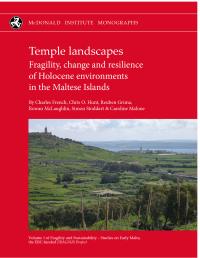
The ERC-funded FRAGSUS Project (Fragility and sustainability in small island environments: adaptation, cultural change and collapse in prehistory, 2013–18), led by Caroline Malone (Queens University Belfast) has explored issues of environmental fragility and Neolithic social resilience and sustainability during the Holocene period in the Maltese Islands. This, the first volume of three, presents the palaeo-environmental story of early Maltese landscapes.
The project employed a programme of high-resolution chronological and stratigraphic investigations of the valley systems on Malta and Gozo. Buried deposits extracted through coring and geoarchaeological study yielded rich and chronologically controlled data that allow an important new understanding of environmental change in the islands. The study combined AMS radiocarbon and OSL chronologies with detailed palynological, molluscan and geoarchaeological analyses. These enable environmental reconstruction of prehistoric landscapes and the changing resources exploited by the islanders between the seventh and second millennia bc. The interdisciplinary studies combined with excavated economic and environmental materials from archaeological sites allows Temple landscapes to examine the dramatic and damaging impacts made by the first farming communities on the islands’ soil and resources. The project reveals the remarkable resilience of the soil-vegetational system of the island landscapes, as well as the adaptations made by Neolithic communities to harness their productivity, in the face of climatic change and inexorable soil erosion. Neolithic people evidently understood how to maintain soil fertility and cope with the inherently unstable changing landscapes of Malta. In contrast, second millennium bc Bronze Age societies failed to adapt effectively to the long-term aridifying trend so clearly highlighted in the soil and vegetation record. This failure led to severe and irreversible erosion and very different and short-lived socio-economic systems across the Maltese islands.
Charles French is Professor of Geoarchaeology in the Department of Archaeology, University of Cambridge.
Chris O. Hunt is a Professor in the School of Biological and Environmental Sciences, Liverpool John Moores University, Liverpool.
Reuben Grima is a Senior Lecturer in the Department of Conservation and Built Heritage, University of Malta.
Rowan McLaughlin is Senior Researcher in the Department of Scientific Research at the British Museum and honorary research scholar at Queen’s University Belfast.
Caroline Malone is a Professor in the School of Natural and Built Environment, Queen’s University Belfast.
Simon Stoddart is Reader in Prehistory in the Department of Archaeology, University of Cambridge.
The Isola Sacra Survey: Ostia, Portus and the port system of Imperial Rome
edited by Simon Keay, Martin Millett, Kristian Strutt and Paola Germoni
Hardback | £48.00 / US$60.00 | ISBN 978-1-902937-90-8 | xxi + 200 pp. | 120 figs | 7 tables | 2020 | Buy now
eBook | ISBN 978-1-902937-94-6 | xxi + 200 pp. | 120 figs | 7 tables | 2020 | Download now for free
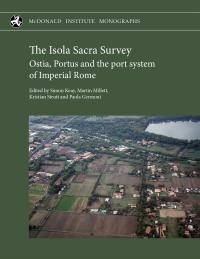
The Isola Sacra occupies the land between Ostia and Portus at the mouth of the Tiber, and thus lies at the centre of the massive port complex that served Imperial Rome. The area has been the focus of archaeological research since the 16th century, but has never before been the subject of an integrated survey. This volume focuses on the results of a survey completed between 2002 and 2012 as part of the Portus Project. It complements our previous survey of Portus (2005) and the forthcoming publication of the German Archaeological Institute’s survey of Ostia. It included a fluxgate gradiometer survey of all the available open ground on the island (c 98 ha), as well as selective Ground-Penetrating Radar survey and an analysis of satellite and aerial photographic images. A presentation of these results is set against an analysis of the geomorphology of the delta, and integrated with information from past excavations in the area. It is complemented by a programme of geoarchaeological coring and a short account of the ships excavated on the Isola Sacra in 2011.
The results make an important contribution to the understanding of a landscape that is key to the understanding of both Portus and Ostia. They provide new information about the development of the delta, and the changing use of Isola Sacra, which was artificially created when a canal was dug during the construction of the harbour at Portus in the middle of the first century AD. It provides additional evidence for the buildings along its northern shore and the cemeteries that flank this settlement and line the via Flavia (which runs between Portus and Ostia across the centre of the island). Most significantly however, the survey revealed completely new evidence of three new sets of features. First, it has mapped a major canal that ran north–south across the island, linking the canal system of the harbour at Portus with Ostia. Second, it has provided extensive evidence of systematic land divisions, which created blocks of fields across the centre of the island. Finally, it has revealed details of a suburb of Ostia on the southern flank of the island, opposite the extensively excavated remains of Ostia Antica. This area was defined by a massive, but hitherto unknown, town wall within which is an extensive series of warehouses. These results are key for understanding the development of Portus–Ostia complex, and hence the economy of the City of Rome itself.
Simon Keay is a Professor of Archaeology at the University of Southampton and a Fellow of the British Academy. He specialises in the archaeology of the Roman Empire, with particular interests in Italy and Iberia, Roman Mediterranean ports and commerce and culture change. He has directed a range of excavations and surveys in Italy, Spain and Turkey.
Martin Millett is the Laurence Professor of Classical Archaeology at the University of Cambridge, a Fellow of Fitzwilliam College and a Fellow of the British Academy. His research focuses on the social and economic archaeology of the Roman world and the application of survey methods in archaeology, and has involved fieldwork in the UK, Spain, Portugal and Italy.
Kris Strutt is an Experimental Officer in Archaeology at the University of Southampton. He specialises in archaeological mapping and geophysical survey. He has led numerous research surveys in the UK, Europe and further afield, including the survey of Portus.
Paola Germoni is Funzionario Archeologo at the Parco Archeologico di Ostia Antica. She has responsibility for the management of the archaeology in the Isola Sacra for many years, and is author of many articles on recent archaeological discoveries.
Pattern and process Landscape prehistories from Whittlesey Brick Pits: the King’s Dyke & Bradley Fen excavations 1998–2004
CAU Must Farm/Flag Fen Basin Depth & time Series - Volume 1
authored by Mark Knight and Matt Brudenell
Hardback | £45.00 / US$57.00 | ISBN-978-1-902937-93-9 | xxi + 418 pp. | 217 figs | 110 tables | 2020 | Buy now
eBook | ISBN-978-1-902937-97-7 | xxi + 418 pp. | 217 figs | 110 tables | 2020 | Download for free
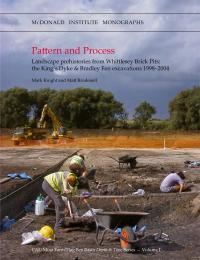
The King’s Dyke and Bradley Fen excavations occurred within the brick pits of the Fenland town of Whittlesey, Cambridgeshire. The investigations straddled the south-eastern contours of the Flag Fen Basin, a small peat-filled embayment located between Peterborough and the western limits of Whittlesey ‘island’. Renowned principally for its Bronze Age discoveries at sites such as Fengate and Flag Fen, the Flag Fen Basin also marked the point where the prehistoric River Nene debouched into the greater Fenland Basin.
A henge, two round barrows, an early fieldsystem, metalwork deposition and patterns of sustained settlement along with metalworking evidence helped produce a plan similar in its configuration to that revealed at Fengate. In addition, unambiguous evidence of earlier second millennium BC settlement was identified together with large watering holes and the first burnt stone mounds to be found along Fenland’s western edge.
Genuine settlement structures included three of Early Bronze Age date, one Late Bronze Age, ten Early Iron Age and three Middle Iron Age. Later Bronze Age metalwork, including single spears and a weapon hoard, was deposited in indirect association with the earlier land divisions and consistently within ground that was becoming increasingly wet.
The large-scale exposure of the base of the Flag Fen Basin at Bradley Fen revealed a beneath-the-peat or pre-basin landscape related to the buried floodplain of an early River Nene. Above all, the revelation of sub-fen occupation means we can now situate the Flag Fen Basin in time as well as space.
Hinterlands and Inlands: The Archaeology of West Cambridge and Roman Cambridge Revisited
CAU Landscape Archives New Archaeologies of the Cambridge Region Series (3)
authored by Christopher Evans and Gavin Lucas
Hardback | £45.00 / US$5700 | ISBN-978-1-902937-89-2 | xix + 528 pp. | 286 figs | 104 tables | 2020 | Buy now
eBook | 978-1-902937-96-0 | xix + 528 pp. | 286 figs | 104 tables | 2020 | Download available soon
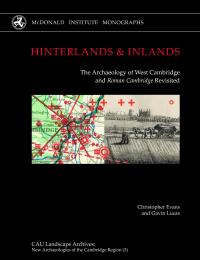
Thinking Hinterlands – Spanning 25 years of fieldwork across a 3 sq. km swathe on the west side of Cambridge, this and its companion volume present the results of 15 sites, including seven cemeteries. The main focus is on the area’s prehistoric ‘inland’ colonization (particularly its Middle Bronze Age horizon) and the dynamics of its Roman hinterland settlements. The latter involves a variety of farmsteads, a major roadside centre and a villa-estate complex, and the excavation programme represents one of the most comprehensive studies of the Roman countryside anywhere within the lands of its former empire. Appropriately, this book also includes a review of Roman Cambridge, appraising its status as a town.
With such a body of amassed data to draw upon, comparative statistical analyses are employed throughout, alongside an array of scientific studies that include ancient DNA. Both books also have a historiographic dimension relating to the landscape’s specific suburban situation and its latter-day colonization by the University. Earlier excavations by Jenkinson at Girton College and Marr’s Traveller’s Rest Pit investigations are reviewed, with the ‘archaeology’ of the Darwin Family Estate and the Newall Telescope also featured.
The collective results are groundbreaking. This was a densely packed landscape, and the scale and coherence of the cumulative excavation programme provides significant insights concerning prehistoric and Roman-period settlement densities. What their proximity implies for economic and social practices, and the area’s long-term land-use succession – the comings and goings of communities and ‘history’ – are explored in depth.
2019
Fuel and Fire in the Ancient Roman World: Towards an integrated economic understanding
edited by Robyn Veal & Victoria Leitch
eBook | ISBN 978-1-902937-91-5 | xi + 137 pp. | 47 figs | 20 tables | 2020| Download for free
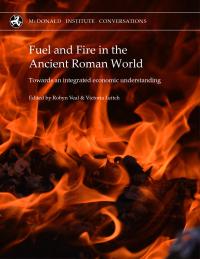
The study of fuel economics in the Roman, or indeed in any ancient world, is at a pivotal point. New research in archaeological science, the ancient economy, the ancient environment, and especially, the increasing collection of bio-archaeological datasets, are together providing a greatly enriched resource for scholars. This volume makes a first attempt to bridge the gap between ‘top-down’ generalized models about Roman energy consumption with the ‘case study’ detail of archaeological data in the Mediterranean. The papers here are the work of scholars from a variety of disciplines: from archaeobotanists and historians to archaeologists specialising in social, technical and economic fields.
A more nuanced view of the organization of the social and industrial structures that underpinned the fuel economy arises. Although focused on the Roman period, some papers extend beyond this era, providing contextual relevance from the proto-historic period onwards. Much exciting interdisciplinary work is ahead of us, if we are to situate fuel economics more clearly and prominently within our understanding of Roman economics, and indeed the ancient Mediterranean economy.
Robyn Veal is a researcher at the McDonald Institute for Archaeological Research, and a Quondam fellow at Hughes Hall, University of Cambridge. At the time of writing she was an honorary research fellow at the University of Sydney, and spent time as a Ralegh Radford fellow at the British School at Rome. She works with a number of international excavation teams as an environmental archaeology advisor and charcoal specialist.
Victoria Leitch has a D.Phil from the University of Oxford on the production and trade of Roman North African cooking wares. She currently works as the Publications Manager for the Society for Libyan Studies.
Towards a Broader View of Hunter-Gatherer Sharing
edited by Noa Lavi & David E. Friesem
eBook | ISBN-978-1-902937-92-2 | xiii + 245pp. | 42 figs | 25 tables | 2019| Download for free
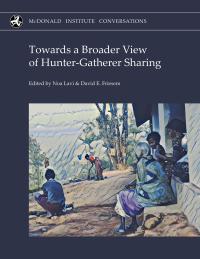
The practice of sharing food among hunting and gathering societies has attracted significant scholarly attention from anthropological, evolutionary and archaeological perspectives. This edited monograph offers to broaden the view of the practice of sharing to include sharing of space, actions, land, knowledge, time, self and identity. The chapters in this book present ethnographic, archaeological and theoretical cases from different periods of time, diverse communities and environments across the world to demonstrate how perceptions, values and mechanics previously assigned to food sharing, are applied to other tangible and intangible forms of sharing. The cross-disciplinary integration between archaeologists and biological and social anthropologists expands the understanding of what is socially required for sharing, how it is practiced and experienced, what it allows and what are its social and evolutionary implications. The new concepts and understandings of sharing that emerge from this book provide a multi-layered framework which can be applied in various contexts aiding in unravelling new intangible aspects of this core social practice. This monograph raises an insightful and timely discussion about the evolution and social complexity of non-agrarian societies in general and provides new tools and ideas to explore the complexity and diversity in the social world of past and contemporary societies
Medieval to modern suburban material culture and sequence at Grand Arcade, Cambridge
authored by Craig Cessford and Alison Dickens
Hardback | £45 /US$60.00 | ISBN-978-1-902937-78-6| xxi + 474pp. | 260 figs | 56 tables | 2019 | Buy now
eBook | 978-1-902937-95-3 | xxi + 474pp. | 260 figs | 56 tables | 2019| Download for free
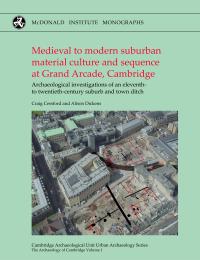
This is the first volume describing the results of the CAUs excavations in Cambridge and it is also the first monograph ever published on the archaeology of the town. At 1.5 hectares the Grand Arcade investigations represent the largest archaeological excavation ever undertaken in Cambridge, significantly enhanced by detailed standing building recording and documentary research. It includes one of the most comprehensive studies of the suburb of a British town, with fourteen investigated plots of the mid/late eleventh to twentieth centuries, and the most detailed investigation of a British town ditch ever undertaken, spanning the early/mid-twelfth to eighteenth centuries. Major artefactual assemblages of many material types were recovered, with extensive waterlogged preservation of wood and leather plus environmental sampling, including pollen and insects. The volume treats the copious eighteenth–twentieth-century material culture in a manner unparalleled in a British context, including a considerable number of college related items that attest to the town’s distinctive role as a university centre.
This is an important book, and the scale of the investigations and the richness of the archaeology make it a major contribution to studies of British town suburbs and boundaries in particular and urban archaeology more generally. The ground-breaking commitment to the archaeology of the eighteenth–twentieth-centuries is particularly important, as Cambridge was one of the key intellectual hubs of the foremost global power for much of the period.
The Evolution of Fragility: Setting the Terms
edited by Norman Yoffee
eBook | ISBN- 978-1-902937-88-5 | x + 194 pp. | 67 figs | 1 table | 2019 | Download for free

Explanations for the collapse of early states (and complex societies) often assume that they were integrated and stable until something bad happened, usually environmental change or because enemies overwhelmed them. In fact, many of these early states lasted a relatively short time, at least in archaeological reckoning. Others were longer-lived, but struggled to overcome structural weaknesses that eventually resulted in the fragmentation or a large-scale undoing of political orders. Rulers who attempted to institute mechanisms of control often laid the conditions for resistance and the disintegration of their regimes. The central theme of this volume is to undermine some traditional themes that naturalize the state and legitimize its historical claims to permanence.
Far from the Hearth: Essays in Honour of Martin K. Jones
edited by Emma Lightfoot, Xinyi Lui and Dorian Q. Fuller
eBook | ISBN- 978-1-902937-87-8 | xii + 210 pp. | 41 figs | 16 tables | 2019 | Download for free
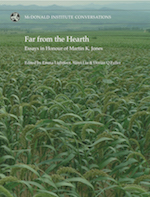
The essays in this volume honour a man whose research over the last four decades has exemplified the potential of archaeology, archaeological science and their cognate disciplines to address central questions about food and human nature. The volume comprises 17 thematic papers, all focused on the archaeology of food and arranged into three sections reflecting Martin Jones’ wide-ranging career. The first section, A Botanical Battleground, honours his central role in the development of archaeobotany and biomolecular archaeology. The second, The Stomach and the Soul, discusses the archaeology of food from evolutionary perspectives; while the final section, Between Fertile Crescents, connects to his recent research on food globalization in prehistory.
The assembled chapters emphasize not only the food itself, but also the communities who produced and consumed it, as Martin Jones has repeatedly demonstrated that it is the interconnection between social and biological discourses that sheds most light on the human past. Far from the time when the first hearth was ever built, the research of archaeologists connects the meals of the present to past communities and their interconnections to each other and to plants.
Emma Lightfoot, BA MSc PhD is a Post-doctoral Research Fellow at the McDonald Institute for Archaeological Research, University of Cambridge, specializing in stable isotope analysis and interested in the social, cultural and environmental aspects of diet.
Xinyi Liu, BA PhD is an assistant professor in the Department of Anthropology, Washington University in St. Louis, with research interests in the origins of agriculture, food globalizations in the past and ‘lost crops’ in East Asia.
Dorian Q Fuller, BA MPhil PhD is Professor of Archaeobotany at University College London, working on plant domestication and early agricultural systems in various countries of Asia and Africa.
2018
The Marble Finds from Kavos and the Archaeology of Ritual
edited by Colin Renfrew, Olga Philaniotou, Neil Brodie, Giorgos Gavalas & Michael J. Boyd
Hardback | £63 / US$82.00 | ISBN-978-1-902937-77-9| xxii + 600 pp. | 387 figs | 157 tables | 2018 | Buy now
eBook | ISBN- 978-1-902937-86-1 | xxii + 600 pp. | 387 figs | 157 tables | 2018 | Download for free
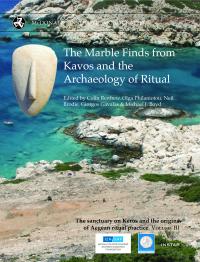
During the 1960s large numbers of Early Cycladic sculptures of marble, often broken, appeared on the illicit market. These were usually of the strikingly simple form of the folded-arm figure of marble long-known from the Early Cycladic cemeteries. Excavations at Kavos on the island of Keros revealed a location later named the ‘Special Deposit North’, from which these had been looted. During the years 2006-2008 systematic excavations at a location 110m to the south revealed a hitherto undisturbed location, the Special Deposit South, from which hundreds more of these broken Cycladic figures were recovered.
This volume describes in detail the marble sculptures and marble vessels, almost always broken in the course of ritual practice, which formed the key part of the systematic depositions undertaken at this time during the Early Bronze Age from ca. 2750-2300 BC. Details of the excavation were reported in Volume II. Here in Volume III the remarkable marble finds from the systematic excavation are fully described and illustrated.
The volume offers a systematic discussion of the Special Deposits at Kavos in relation to the adjacent settlement at Dhaskalio, seen in their Aegean perspective at the conclusion of the excavations in 2008. The sanctuary on Keros is recognized as a key site for the emergence of ritual practice in the Aegean.
An Age of Experiment: Classical Archaeology Transformed (1976–2014)
edited by Lisa Nevett and James Whitley
Hardback | £45 /US$60.00 | ISBN-978-1-902937-80-9| xv + 250pp. | 79 figs | 10 tables | 2018 | Buy now
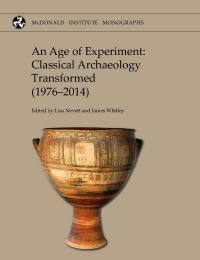
What is Classical Archaeology’s place within the overall study of antiquity and the history of humanity? And what is its relationship to its kindred disciplines of ancient history, art history and Mediterranean prehistory? Forty or so years ago Classical Archaeology appeared to be a very conservative and rather niche area of scholarly endeavour. Then both prehistorians and ancient historians might have answered that Classical Archaeology had little to offer their respective fields of study. Since the late 1970s, however, the subject has been transformed, a transformation in which the example of Anthony Snodgrass has played a significant role. This volume brings together the work of Snodgrass’s former students; scholars who, while they could be variously classified as prehistorians, ancient historians, Classical archaeologists, Classical art historians, Classicists and modern historians, are internationally recognised scholars in their respective fields. Each contribution brings a unique perspective to bear on the current state of Classical archaeology and its place in not only Mediterranean but global history, art history and archaeology.
Authenticity and cultural heritage in the age of 3D digital reproductions
edited by Paola Di Giuseppantonio Di Franco, Fabrizio Galeazzi and Valentina Vassallo
eBook | ISBN-978-1-902937-85-4 | xii + 138 pp. | 62 figs | 2018 | Download for free

This volume represents the first attempt to collate an organic collection of contributions on authenticity and the digital realm in heritage and archaeology. It analyses the concept of authenticity from different perspectives and with different multidisciplinary contributions, together with theoretical debate. The collection of papers explores the concept of authenticity in a comprehensive way, engaging with theories relating to the commodification of ancient material culture, heritage-making processes, scholarly views and community engagement.
These papers also take into account current digital practices for the study of past material culture and how their use affects and redefines interpretation processes in archaeology. This will provide a key reference text for archaeologists, museum and heritage specialists, and other readers interested in authenticity, cultural heritage and 3D reproductions.
Riversides: Neolithic barrows, a Beaker grave, Iron Age and Anglo-Saxon burials and settlement at Trumpington, Cambridge
authored by Chris Evans, Sam Lucy and Ricky Patten
Hardback | £45 /US$60.00 | ISBN-978-1-902937-84-7| xviii + 484 pp. | 241 figs | 118 tables | 2018 | Buy now
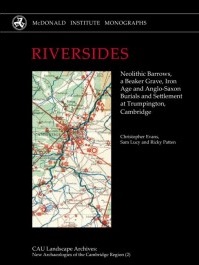
The 2010–11 excavations along Trumpington’s riverside proved extraordinary on a number of accounts. Particularly for its ‘dead’, as it included Neolithic barrows (one with a mass interment), a double Beaker grave and an Early Anglo-Saxon cemetery, with a rich bed-burial interment in the latter accompanied by a rare gold cross. Associated settlement remains were recovered with each. Most significant was the site’s Early Iron Age occupation. This yielded enormous artifact assemblages and was intensively sampled for economic data, and the depositional dynamics of its pit clusters are interrogated in depth.
Not only does the volume provide a summary of the development of the now widely investigated greater Trumpington/ Addenbrooke’s landscape – including its major Middle Bronze Age settlements and an important Late Iron Age complex – but overviews recent fieldwork results from South Cambridgeshire. Aside from historiographical-themed Inset sections, (plus an account of the War Ditches’ Anglo-Saxon cemetery and Grantchester’s settlement of that period), there are detailed scientific analyses (e.g. DNA, isotopic and wear studies of its utilized human bone) and more than 30 radiocarbon dates were achieved.
The concluding chapter critically addresses issues of local continuity and de facto notions of ‘settlement evolution’.
2017
Delicate urbanism in context: Settlement nucleation in pre-Roman Germany
edited by Simon Stoddart
ebook | ISBN - 978-1-902937-83-0 | viii + 136 pp. | 67 figs | 4 tables | 2017 | Download for free
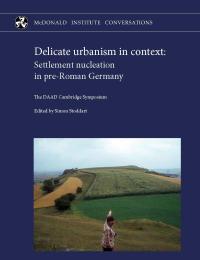
This volume brings together the latest understanding of pre-Roman German urbanism from seven German scholars, accompanied by a contextualizing commentary from five further scholars, based in the UK and America. The result is a dissection of the different dimensions of a delicate urbanism that compares and contrasts with other examples of sometimes more robust urbanism in other parts of first millennium bc Europe. The papers concentrate on examples in Baden-Württemberg and Bavaria, but range as far as Rome and Athens in making comparisons. The analysis takes both a quantitative and qualitative approach, investigating both the first Hallstatt (sixth/fifth centuries bc) and second La Tène (last few centuries bc) cycles of nucleation, assessing rural settlement and burial, as well as the underlying forces of ritual and production.
Boeotia Project, Volume II: The city of Thespiai: survey at a complex urban site
edited by John Bintliff, Emeri Farinetti, Božidar Slapšak and Anthony Snodgrass
Hardback | £70 /US$90.00 | ISBN-978-1-902937-81-6 | xviii + 414 pp. | 287 figs | 41 tables | supplementary cd | 2017 | Buy now
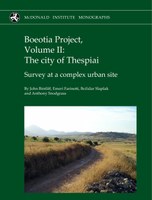
Few major Classical cities have disappeared so completely from view, over the centuries, as Thespiai in Central Greece. Only the technique of intensive field survey, carefully adapted to a large urban site and reinforced by historical investigation, has made it possible to recover from oblivion much of its life of seven millennia. This is the much anticipated second volume to 'Testing the hinterland: the work of the Boeotia Survey (1989–1991) in the southern approaches to the city of Thespia' that was published in the Monograph Series in 2007.
2016
The archaeology of the Niah Caves, Sarawak (Volume II)
edited by Graeme Barker and Lucy Farr
Hardback | £65 /US$94.00 | ISBN-978-1-902937-60-1 | xxx+562 pp. | 298 figs | 115 tables | supplementary cd | 2016 | Buy now
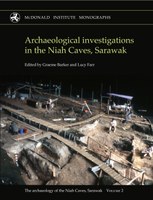
This book is the companion volume to Rainforest Foraging and Farming in Island Southeast Asia: the Archaeology of the Niah Caves, Sarawak. Together, they describe the most significant results of the Niah Caves Project, a recent investigation by an inter-disciplinary team of over 70 researchers of the archaeology of the cathedral-like Niah Caves and of the wealth of materials collected by Tom and Barbara Harrisson in their 1950s and 1960s excavations. Volume 1 integrated the results of the project in an account of how our species developed diverse ways of living in rainforest from the time of first arrival in Borneo 50,000 years ago to recent centuries, profoundly shaping it in the process.
This volume presents the detailed information on which those arguments are based, with chapters describing the NCP fieldwork, the reconstruction of past climates and environments, establishing chronological frameworks, and analysing and interpreting the suites of artefacts and biological materials collected by the previous and new work in the caves. Where appropriate, the text is augmented by supplementary materials. This second volume of the project confirms the unique importance of the Niah Caves for rainforest archaeology, described in the light of Volume 1 as “unsurpassed worldwide in the context of reconstructing…human rainforest subsistence foraging strategies” (World Archaeology, 2015).
Graeme Barker is Emeritus Disney Professor of Archaeology at the University of Cambridge and a Senior Research Fellow in the McDonald Institute for Archaeological Research. His research focuses on the interactions between past human societies and the environments they inhabited, especially relating to the transition from hunting and gathering to farming and, more recently, the dispersal of our species.
Lucy Farr is a Research Fellow in the McDonald Institute for Archaeological Research, University of Cambridge. Her research focuses on palaeoenvironments, prehistoric hunter-gatherers, and field methodologies including remote sensing.
The pottery from Dhaskalio: the sanctuary on Keros and the origins of Aegean ritual practice
edited by Peggy Sotirakopoulou with a contribution by Colin Renfrew
Hardback | £64 /US$85.00 | ISBN-978-1-902937-76-2 | xvii+477 pp. | 392 figs | 63 tables | supplementary cd | 2016 | Out of Stock
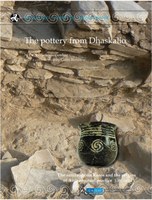
This is the fourth volume in 'The Sanctuary on Keros and Origins of Aegean Ritual Practice: the excavations of 2006-2008' series. It treats in detail the pottery from the settlement on the islet of Dhaskalio, whose excavation is described in Volume I of the series. Much of the importance of this material lies in the undisturbed stratigraphy of the settlement, a fact that allowed for the recognition of three successive phases of occupation of the site with considerable ceramic continuity between them, as well as for safe inferences about its chronology, with wider implications for the later early bronze age of the Cyclades. Other important aspects of this pottery are its considerable regionalism and the fact that it is almost in its entirety imported. The study of the pottery and other finds from the site suggest that the settlement at Dhaskalio may have operated primarily as a place for periodic rather than permanent habitation and that its function was most probably connected with the rituals practised at the opposite Special Deposits at Kavos. The character of Deposits at Kavos seem to have declined, and the site may increasingly have grown to be a centre of commercial exchange with other islands and areas.
Peggy Sotirakopoulou holds a PhD from the University of Athens and has been lecturer in the University of Crete and Curator at the Museum of Cycladic Art in Athens. Her doctoral research was published as a monograph on the neolithic and early bronze age pottery of Akrotiri, Thera, and she is author of The 'Keros Hoard': Myth or Reality, and (with N.C. Stampolidis) Aegean Waves: Artworks of the Early Cycladic Culture.
Twice-crossed river: prehistoric and palaeoenvironmental investigations at Barleycroft Farm/Over Cambridgeshire
authored by Christopher Evans with Jonathan Tabor and Marc Vander Linden
Hardback | £40 /US$58.00 | ISBN-978-1-902937-75-5 | xxiii+639 pp. | 301 figs | 178 tables | 2016 | Buy now
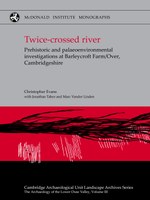
This is the first volume charting the CAU’s on-going Barleycroft Farm/Over investigations, which now encompasses almost twenty years of fieldwork across both banks of the River Great Ouse at its junction with the Fen. Amongst the project’s main directives is the status of a major river in prehistory – when a communication corridor and when a divide? Accordingly, a key component throughout has been the documentation of the lower Ouse’s complex palaeoenvironmental history, and a delta-like wet landscape dotted with mid-stream islands has been mapped. This book is specifically concerned with the length of The Over Narrows, whose naming alludes to an extraordinary series of mid-channel ‘river race’ ridges. With their excavation generating vast artefact sets and unique palaeo-economic data, these ridges saw intense settlement sequences, ranging from Mesolithic camps, Grooved Ware, Beaker and Collared Urn pit clusters (plus field plots) to Middle Bronze fieldsystems and their attendant settlements, a massive Late Bronze Age midden complex and, finally, an Iron Age shrine. The latter involved extensive human bone or body-part deposition and bird sacrifice. Four upstanding turf barrows and two accompanying waterlogged pond barrows feature among the main excavations reported here. With more than 40 cremations (including in situ pyres), the resultant detailing of Early Bronze Age mortuary practices and the insights into the period’s monument construction are ground-breaking. This is an important book, for the scale of The Narrows’ excavations and palaeoenvironmental studies, its comprehensive dating programmes and, particularly, the innovative methodologies and analyses undertaken. Indeed, a commitment to experiment has lain at the project’s core.
Christopher Evans is the Executive Director of the Cambridge Archaeological Unit, University of Cambridge, which he co-founded with Ian Hodder, in 1990. He has directed a wide variety of major fieldwork projects, both abroad (Nepal, China & Cape Verde) and in the UK.
The provincial archaeology of the Assyrian Empire
edited by John MacGinnis, Dirk Wicke and Tina Greenfield
Hardback | £80 /US $116.00 | ISBN-978-1-902937-74-8 | xviii+390 pp. | 179 figs | 17 tables | 2016 | Buy now
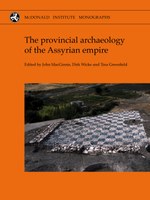
The Assyrian empire was in its day the greatest empire the world had ever seen. Building on the expansion of the Middle Assyrian state in the late second millennium BC, the opening centuries of the first millennium witnessed a resurgence which led to the birth of a true empire whose limits stretched from Egypt to Iran and from Anatolia to the Persian Gulf. While the Assyrian imperial capital cities have long been the focus of archaeological exploration, it is only in recent decades that the peripheral areas have been the subject of sustained research. This volume sets out to synthesise the results of this research, bringing together the outcomes of key investigations from across the empire. The provincial archaeology of the empire is presented in a new light, with studies of the archaeological imprint of Assyria in present-day Israel, Iran, Iraq, Syria and Turkey. A wide range of methodological and interpretive approaches are brought to bear on the data. Analyses of environmental zones and ecofactual datasets, material culture and architectural traditions, the permeation of literacy and the use of para-literate systems form the platform for innovative and integrative evaluations and lead to a new appreciation for the diversity of local responses to the Assyrian expansion.
John MacGinnis is based in the Middle East Department of the British Museum and is a Research Affiliate of the McDonald Institute for Archaeological Research; his research focuses on the archaeology and epigraphy of Mesopotamia of the first millennium BC.
Dirk Wicke holds the chair for Near Eastern Archaeology at the Goethe-University Frankfurt a.M. He studied in Münster, London and Mainz; his major research interests are minor arts and crafts in the Iron Age.
Tina Greenfield is a Research Associate and Co-director of the Near Eastern and Biblical Archaeology Lab at the University of Manitoba. She also teaches at the University of Winnipeg, and is a Visiting Research Scholar at the University of Cambridge McDonald Institute for Archaeological Research; her research focuses on the political economy of early states and empires through the study of zooarchaeological remains.
Kavos and the special deposits: the sanctuary on Keros and the origins of Aegean ritual
edited by Colin Renfrew, Olga Philaniotou, Neil Brodie, Giorgos Gavalas and Michael Boyd
Hardback | £64 /US $92.00 | ISBN-13-978-1-902937-70-0 | xxx + 614 pp. | 485 figs | 82 tables | 2016 | Buy now
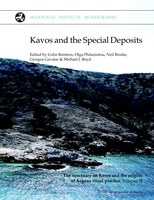
This is the second volume in 'The Sanctuary on Keros and Origins of Aegean Ritual Practice: the excavations of 2006-2008' series. It describes the excavation and finds from the Special Deposits at Kavos at the sanctuary on Keros lying opposite the settlement on the islet of Dhaskalio (described in Volume I). The finds of marble from the Special Deposit South are described in Volume III, and the pottery in Volume V. The sanctuary at Kavos, dating from c. 2700 BC to 2400 BC has yielded the richest ritual deposits of the early bronze age Cyclades. The finds are presented here in their excavation contexts, and the significance of the Special Deposit South as a ritual deposit is examined in the context of Aegean prehistory
Colin Renfrew (Lord Renfrew of Kaimsthorn, born 25th July 1937) was formerly Disney Professor of Archaeology and Director of the McDonald Institute for Archaeological Research in the University of Cambridge, and Master of Jesus College Cambridge from 1986 to 1997. He has excavated at a number of sites in prehistoric Greece and in the Orkney Islands.
Neil Brodie has held positions at the British School at Athens, the McDonald Institute for Archaeological Research, Stanford University’s Archaeology Center, and the Scottish Centre for Crime and Justice Research at the University of Glasgow. He has worked on archaeological projects in the United Kingdom, Greece and Jordan, and continues to work in Greece.
Giorgos Gavalas is an independent scholar, a Fellow of the Archaeological Society of Athens and currently Secretary of the Cycladic Studies Society. His main research interests lie in the archaeology of the Cyclades, both prehistoric and classical, and he is a specialist in textile tools and stone vessels.
Michael Boyd is a Senior Research Associate at the McDonald Institute for Archaeological Research. His main research interests lie in the archaeology of death and in the prehistoric Aegean, where he has worked in the Peloponnese and Cyclades.

